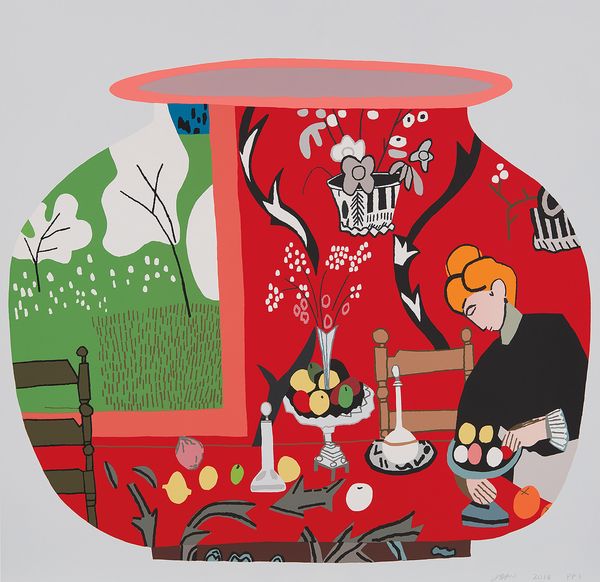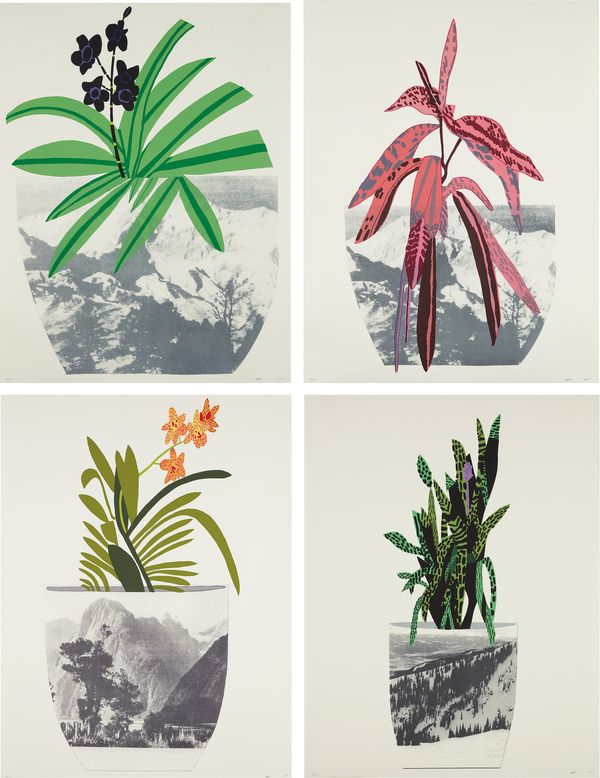Jonas Wood Matisse Pot 2 from Matisse Pot 1; Matisse Pot 2; and Matisse Pot 3, 2017-18
"I've also started to collect prints and look at prints, and see how other people have made prints—I just got this Lichtenstein print, a brushstroke one," Jonas Wood told Jacob Samuel. "And when I started examining it, I discovered how amazing it was that he could translate his work so directly into printmaking. So yes, it really opens up—a few years after we started I realized that drawing had always informed my painting; then I saw how collage had informed it. But once printmaking entered the equation, that also started informing my painting and vice versa. Even when thinking about the process of making a painting, I started taking cues from printmaking and putting them back into paintings."
Excerpt from Art in Print, vol. 8, no. 1, 2018
Jonas Wood: Collaborating with Jean Milant at Cirrus in 2009 was my real first experience making a set of editions with a print house. I had been in a three-person show at his gallery in 2006. I didn't know much about him then, but I went to his gallery and realized that he had made all of this amazing stuff with artists I love, like Ed Ruscha and Baldessari and…
Jacob Samuel: Joe Goode…
JW: Chris Burden…
JS: To me, Jean Milant is the great unsung hero of Los Angeles printmaking. He doesn't get the credit he deserves.
JW: We printed all the birds and the birdcages and then I hand-drew all of the details of the birds on each one. That was 2011, and then in 2014, I merged a collage concept with lithography to make cutout photos of landscape pots with silkscreen plants "growing" out of them. I had never used photolithography, I'd always used lithography for drawing (though in my first set with Jean, we used the impression of wood grain to make a floor plane). We have made other things since then. It's like he said, "You can't stop."
Jonas Wood Untitled, 2014. Complete set of four lithographs and screenprint in colors, on Coventry Rag paper. Published by Cirrus Editions, Los Angeles.
JS: You grew up around Boston. Did you go to museums when you were young? Which ones did you like?
JW: Well, certainly the Museum of Fine Arts, Boston. I was interested in figuration and I tried to paint or draw the figure, but I was never really accurate. The modern masters were interesting because they had created their own language in figuration. I remember seeing a lot of Alexander Calder and a lot of art from Asia, like Japanese scrolls. My father was an architect and my mother was a drama teacher. We went to a lot of interesting buildings, like Walter Gropius' house. We went to the [Isabella Stewart] Gardner Museum and the deCordova [Sculpture Park and] Museum, and my parents would take us to New York, where we would visit MoMA, the Metropolitan Museum of Art and the Whitney. And because my grandfather collected, I grew up with art. That was kind of a big deal for me. He had a giant Francis Bacon painting, Picasso prints and Calder drawings. My parents had Andy Warhol's pink and green cow prints, which felt important, but really it was an open-edition wallpaper that came in a couple of different colors. We had this downstairs all 18 years that I lived in my parents' house. And we had Matisse prints, editions from the 1940s and '50s.
We haven't really talked about it, but in the last couple of years, you helped me start my own print house, WKS Editions. We were thinking about setting up a whole silkscreen studio, and then realized that it's probably best to find people who are excellent at this, who we could—not collaborate with—but outsource the work to. So now we are working with Kevin Giffen and Daniel Wlazlak. Kevin was Jeff Wasserman's apprentice. In the last year, we've been making very detailed prints, around 30 colors, of red Matisse pots. We're recreating works of mine that already exist, but making hybrid versions with more immediate drawing on top.
You can't stop.
— Jonas Wood on printmaking
Jonas Wood Matisse Pot 1; Matisse Pot 2; and Matisse Pot 3, 2017-18. Three screenprints in colors, on Rising museum board. Published by WKS (Wood Kusaka Studios), Los Angeles, California.
JS: Well, one of the great things about printmaking is that you can edit. You can add and subtract.
JW: Exactly. So it's perfect because now we've started to work with them, and we can use their studio to make my prints. The only thing that I had to set up was the etching studio, and I started working with your apprentice Sam Gessow. That was when you and I decided to work together and you became my spiritual and professional printmaking guru.
There's not a lot of young people making prints. And I like the idea of establishing that for myself, but also hopefully for other people in the future as time goes on, so I can do the same thing for a young artist that Ruscha did for me.
Founded in 2011 to help champion the printed art form, Art in Print is a bimonthly journal and website that provides important contemporary criticism, fundamental historical research and timely information about current events and exhibitions.


